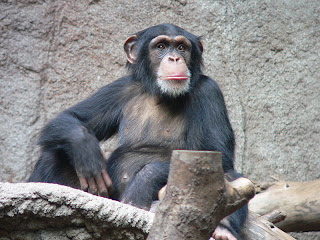I’ve been thinking a lot about how humans use animals due to the readings I was assigned for my zoology class for next week. I like to think that my position on the use of animals is somewhat middle of the road. I believe in animal research, in work animals (like a sheep dog), and I do eat meat. BUT, I am a firm believer in protecting animal welfare and conducting all animal related activities in a humane way.
 |
| Chimpanzee (Pan troglodytes). Source: Wikimedia Commons |
I bring up animal welfare, because I saw an article in the BBC today about a huge raid on suspected illegal animal traders conducted by Gabon’s ministries of water, forestry, and defense. The government agencies weren’t able to save any live animals, but they found enough evidence (heads, hands, skins, etc) to charge the five suspects with poaching.
According to the World Wildlife Federation, the raid resulted in the largest haul of dismembered animals in Central Africa in the last decade. Included in the seizure were parts (I know, awful) of a gorilla, at least 15 chimpanzees (probably several more if the parts came from different animals), 12 leopards, a lion, five elephants, and several snakes.
I feel like animal poaching is the type of issue that can be easy for people to ignore because we associate it with being a far away problem, it can be easy for us to forget about. I realize that there are some cultures that hunt and eat these animals – but selling them for exorbitant prices on the black market, when killing them is illegal in the first place is a problem.
About a year ago I wrote an article for BioTechniques about a new method to track animal poaching using genetic analysis of poached animals. Genetics Cracks Down On Animal Trafficking focuses on animals poached in Nigeria and Cameroon, but it is still an interesting way to crack down on illegal animal trafficking.